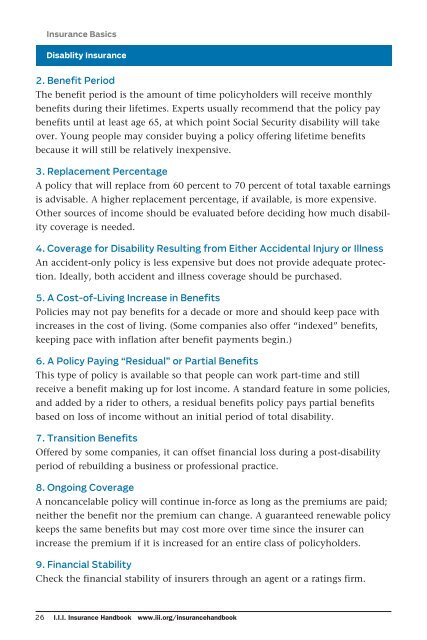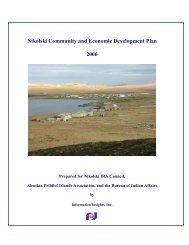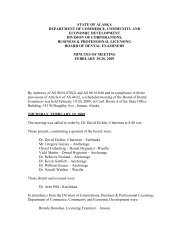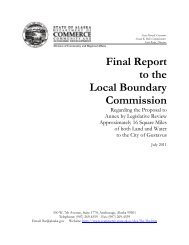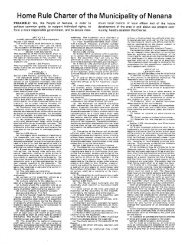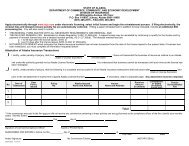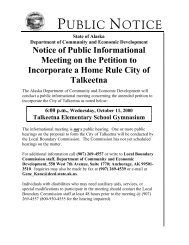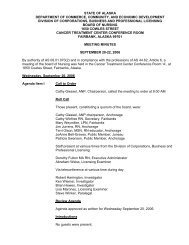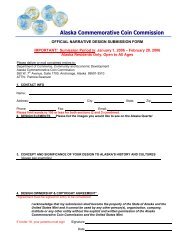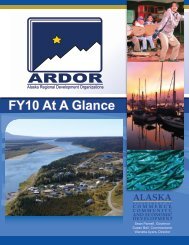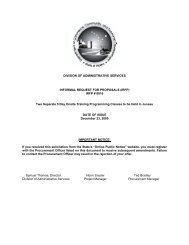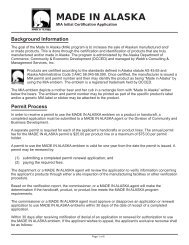Insurance Handbook - Alaska Department of Community and ...
Insurance Handbook - Alaska Department of Community and ...
Insurance Handbook - Alaska Department of Community and ...
You also want an ePaper? Increase the reach of your titles
YUMPU automatically turns print PDFs into web optimized ePapers that Google loves.
<strong>Insurance</strong> Basics<br />
Disablity <strong>Insurance</strong><br />
2. Benefit Period<br />
The benefit period is the amount <strong>of</strong> time policyholders will receive monthly<br />
benefits during their lifetimes. Experts usually recommend that the policy pay<br />
benefits until at least age 65, at which point Social Security disability will take<br />
over. Young people may consider buying a policy <strong>of</strong>fering lifetime benefits<br />
because it will still be relatively inexpensive.<br />
3. Replacement Percentage<br />
A policy that will replace from 60 percent to 70 percent <strong>of</strong> total taxable earnings<br />
is advisable. A higher replacement percentage, if available, is more expensive.<br />
Other sources <strong>of</strong> income should be evaluated before deciding how much disability<br />
coverage is needed.<br />
4. Coverage for Disability Resulting from Either Accidental Injury or Illness<br />
An accident-only policy is less expensive but does not provide adequate protection.<br />
Ideally, both accident <strong>and</strong> illness coverage should be purchased.<br />
5. A Cost-<strong>of</strong>-Living Increase in Benefits<br />
Policies may not pay benefits for a decade or more <strong>and</strong> should keep pace with<br />
increases in the cost <strong>of</strong> living. (Some companies also <strong>of</strong>fer “indexed” benefits,<br />
keeping pace with inflation after benefit payments begin.)<br />
6. A Policy Paying “Residual” or Partial Benefits<br />
This type <strong>of</strong> policy is available so that people can work part-time <strong>and</strong> still<br />
receive a benefit making up for lost income. A st<strong>and</strong>ard feature in some policies,<br />
<strong>and</strong> added by a rider to others, a residual benefits policy pays partial benefits<br />
based on loss <strong>of</strong> income without an initial period <strong>of</strong> total disability.<br />
7. Transition Benefits<br />
Offered by some companies, it can <strong>of</strong>fset financial loss during a post-disability<br />
period <strong>of</strong> rebuilding a business or pr<strong>of</strong>essional practice.<br />
8. Ongoing Coverage<br />
A noncancelable policy will continue in-force as long as the premiums are paid;<br />
neither the benefit nor the premium can change. A guaranteed renewable policy<br />
keeps the same benefits but may cost more over time since the insurer can<br />
increase the premium if it is increased for an entire class <strong>of</strong> policyholders.<br />
9. Financial Stability<br />
Check the financial stability <strong>of</strong> insurers through an agent or a ratings firm.<br />
26 I.I.I. <strong>Insurance</strong> <strong>H<strong>and</strong>book</strong> www.iii.org/insuranceh<strong>and</strong>book


